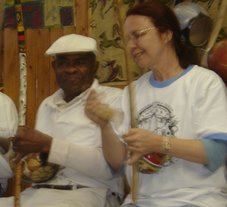
I joined Paris's Capoeira classes at the UCLA International Student Center a few weeks after the mugging incident. My fellow students included the Jamaican-born dancer and drummer Cornell "Sugarfoot" Coley, author Odie Hawkins, the Argentine anthropologist Alejandro Frigerio, Cedric Adams (whose claim to fame includes having his neck snapped by Mel Gibson in Lethal Weapon I), and Steve McCray (a future school principal who appeared alongside Cedric in a Denzel Washington movie). Our teacher, as I recently discovered, had the best film credentials of all, because he had worked with the legendary Brazilian (and Bahian) director Glauber Rocha in the late 60s. At the time, the only one besides Paris with any claim to fame was Odie. All of them were well advanced in their Capoeira skills - brought together and trained by Paris, who modestly and accurately insisted that he was not a "mestre", just an aficionado who was teaching it to others so he could have someone to play with. He was probably in his 40s when we first met. Neither tall nor short, with a lean build and an aquiline nose, he always wore a baseball cap on his closely shaved head due to skin cancer. His personality was gruff and prickly, and he was a very tough teacher, more like a drill sergeant, which was perfect for slackers like me. He also had a hawk-like intelligence that saw right through the mildest of jests (like the time when I gave him a Brazil nut chocolate bar - he immediately perceived the double-entente). Mestre or no mestre, those are essential qualities for anyone who intends to teach Capoeira.
Paris sold me my first berimbau [see Wikipedia definition and photos here] for $30, which seemed cheap at the time till I discovered that you could buy 5 or 6 in Brazil for that price (call it import tax). Fortunately for me, I had taken piano lessons for many years - originally as physiotherapy - and played double bass in high school and an amateur orchestra in the US and UK, so I had some notions of rhythm and coaxing a musical sound out of a string instrument. The tricky thing was balancing a great big berimbau - which looks like, and is, a bow strung with piano wire (usually) with a calabash or gourd (the "sound box") looped onto the lower extremity - and playing it at the same time whilst bouncing the open side of the calabash off my stomach to get a "wah wah" effect. The musician's little finger, yes, the fragile pinky, curls under the string holding the gourd to the bow, and the same hand holds a coin or stone between the thumb and index fingers, which must be free to play the instrument by pressing said coin or stone against the wire. It sounds complicated and is much harder to do than to explain. In the engraving by Carybé that illustrates this entry, you can see the berimbau players in the background. They may be depicted as shadowy figures, but the rhythm they set is essential to the entire business and play of the roda - and the songs sung by the berimbau players, who are usually masters and senior students of the art, are often a running commentary on what the Capoeiristas are doing inside the circle.
"Ginga" needs just one letter to become "gringa" on the printed page, but it is a diametrically opposite concept. Basically, it describes a swaying walk that must be learnt from birth, in contrast with the stiff, linear manner in which most Anglos are raised to put one foot in front of the other as they forge ahead towards their manifest destinies (and heaven forfend if any swaying of hips is involved). In Capoeira, the ginga is a triangular movement in which the body becomes an elastically swaying tripod that serves as the base for any number of moves, from spins to sweeps to cartwheels. And for said Anglos, it is one of the hardest things to learn. Again, in this I was also fortunate because, although I am still relatively "stiff and wooden" compared with most Brazilians, I was raised in the tropics and could at least grasp the concept. Which is not to say that I was any good at Capoeira, particularly at first. The au (cartwheel), which I thought I would learn easily because young kids could do it, stubbornly eluded me. So I went ahead with the set routines Paris taught us, which I later found were part of the Regional training system, and thanked God that at least I could play the berimbau better than most of my classmates. It was my saving grace, and the only reason why I was asked along to Capoeira demonstrations despite my limited skills and unpopular skin colour (more on that later).
This video shows a demonstration of the ginga as I originally learned it (Regional style):


No comments:
Post a Comment